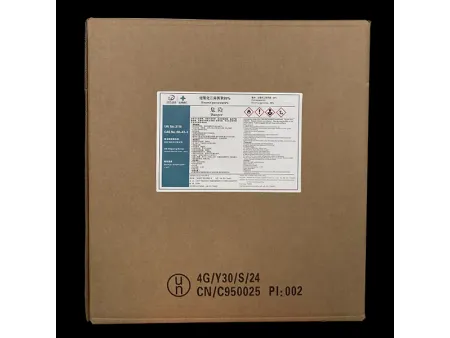Di(tert-butylperoxyisopropyl)benzene (BIPB)
- Chemical Family Organic Peroxide
- Molecular Formula C₂₀H₃₄O₄
- Molecular Weight 338.5
- EINECS 218-664-7
- UN No. 3106
- Sea Transport (IMDG) 5.2
- (organic peroxide, Type D, packing group II)
Half-Life Period
- 0.1 hour 156℃
- 1 hour 134℃
- 10 hours 115℃
- Appearance: White powder or flakes
- Purity: 96% min
- Theoretical active oxygen content: 9.45%
- Major decomposition products: tert-butyl alcohol, diisopropylbenzene, acetylbiphenyl, acetyl-2-hydroxyisopropylbenzene, methane, acetone
- Activation energy: 152.69 kJ/mole
- Self-accelerating decomposition temperature (SADT): 80℃
- Hazardous temperature (Tem): 75℃
- Storage temperature (Ts min/Ts max): --/15 ℃
- Widely used as an initiator for creating polypropylene with controlled rheology, producing materials with a high melt flow index and a consistent molecular structure, which are critical for high-performance applications.
- It also acts as a reliable initiator for styrene polymerization, offering higher molecular weights and increased efficiency in polymerization processes compared to thermal methods.
- In the rubber industry, BIPB is a key vulcanizing agent, offering excellent scorch resistance. It’s often diluted with silicone oil or neutral solvents for safer handling. The safe handling temperature is 135°C, and the cross-linking temperature is 175°C.
-
Packaging
Typically packaged in sturdy 20 kg corrugated boxes, with the option for customized packaging sizes based on specific client needs.
-
Validity
When stored and handled according to the recommended guidelines, BIPB retains its effectiveness for up to six months.
-
Safe Handling
Store in a cool, well-ventilated area, maintaining temperatures below 15°C.
Keep away from fire, heat, and incompatible substances like acids and reducing agents.
Use explosion-proof equipment in the storage area and ensure that switches are located outside the storage zone.
Handle with care to avoid damage to packaging. Use appropriate protective equipment (PPE) when handling the product, especially during transportation or repackaging.
Be sure to review the product's Material Safety Data Sheet (MSDS) before use to ensure proper handling.



